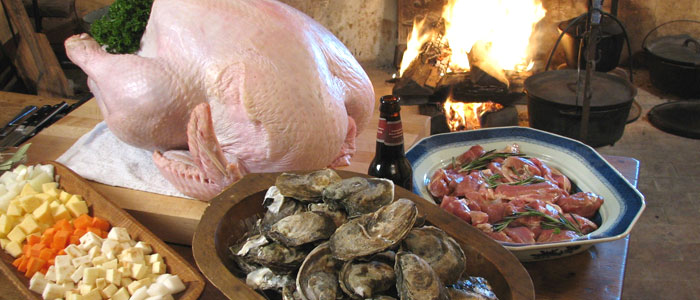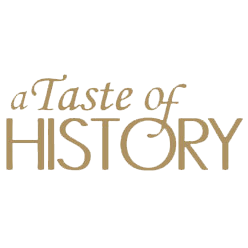
Season One
Martha Washington Won the War
We all know Martha Washington from her portraits as a dowdy grandmother, but did you know that there is new evidence she was a beautiful and passionate wife befitting her handsome George? And that Martha was the secret weapon that kept troop morale high during the hard winter’s encampment at Valley Forge? We prepare Martha’s authentic Turkey Stew with Oysters and speak with well-known Martha Washington expert Patricia Brady.
Early German Settlers
As early as 1690, German settlers left Europe for religious freedom in the new world of North America. They settled in the Philadelphia area, and immediately started to contribute to the innovations and spirit of our new country. In this episode, Chef Walter Staib prepares ale-braised sausages and shows us how his German ancestors helped to make America great.
Von Steuben’s Secret Weapon
General von Steuben was a German officer who volunteered to help Washington battle the British monarchy. Before von Steuben was finished at Valley Forge, he had instituted a discipline to the rag tag army that made them a determined fighting force that would eventually win the war. Chef Staib prepares Braised Rabbit Legs and Potato Cakes in honor of his favorite Continental soldier, General von Steuben.
Washington’s Crossing Pepperpot Soup
In preparation for that all-important Christmas night in 1776 when Washington led his troops across the Delaware River for a surprise attack on the British at Trenton, he ordered one of their heartiest and favorite meals to be ready upon their return, Pepperpot Soup with Cornbread. We conclude the first season of A Taste of History as Chef Staib makes this West-Indies influenced dish again, right at that same spot along the Delaware, with revolutionary troops at his side to celebrate that all important victory.
Jefferson’s Monticello – Pt. 1
We start a special four-part series cooking in Thomas Jefferson’s actual kitchen at Monticello, his Virginia home. Chef Staib prepares Jefferson’s favorite exotic dish, Stuffed Cabbage with Fried Asparagus. We also tour Jefferson’s estate and gardens, where we learn how important discovering and growing foods was to our third President.
Jefferson’s Monticello – Pt. 2
In this next episode at Monticello, we tour “the Dependencies” that housed the beer and wine cellars and the ice house, to learn how 18th Century food was harvested and stored. Chef Staib also borrows Jefferson’ kitchen to prepare Bouilli, a favorite boiled beef dish of Jefferson’s, along with Bouillon Potatoes.
Jefferson’s Monticello – Pt. 3
Jefferson carefully cultivated over 330 vegetable varieties, along with a host of fruits, in his legendary garden. It has been said that everything we need to know about human nature can be learned in Jefferson’s garden. Chef Staib prepares White Bean and Bacon Soup, Chicken Fricassee, and Herbed Barley. We also tour the amazing Monticello Visitor’s Center.
Jefferson’s Monticello – Pt. 4
During his five years abroad as Minister to France, Jefferson’s culinary tastes were refined, and he sought to bring all of French cooking’s recipes and ingredients to the US. In this episode, we get to know James Hemings, Jefferson’s slave cook who accompanied Jefferson to learn the ways of French cuisine. We also meet Jefferson’s long-time Monticello cooks, Edith Hern Fossett and Fanny Hern. Chef Staib prepares a tour-de-force final meal in Jefferson’s kitchen: Curried Lamb and with Rice Pilaf and Stewed Mushrooms, along with Leni Sorensen, Monticello’s expert on the slave cooks who worked there.
Root Cellars
Wild geese were plentiful in 18th Century America and were prized both for their meat and their layer of fat. Chef Staib prepares a typical winter meal of Goose with Turnips, along with Crab Cake with Herb Remoulade. We also visit Harriton House and see how a root cellar was a key part of 18th Century kitchens.
Hercules: Slave Chef to the Washingtons
The foundations of the President’s Residence in Philadelphia, where Washington lived, have recently been excavated, showing where the slave quarters were located in the original White House. The Washingtons relied upon and highly regarded their slave chef, Hercules, who was known to all guests as the best chef in the country. In this episode, Chef Staib prepares a Hercules signature dish, Veal Olives, along with a White Bean and Shallot Purée.
West Indies Influence
18th Century Philadelphia was on the Southern trade route, with ships arriving daily from the West Indies. In this episode, we discover that dishes like Salmon Escoveitch and Salmon Corn Cakes got their flair from West Indies spices, which were abundant in that era. We are also introduced to the Subscription Room – the world news headquarters of its time.
Ben Franklin’s Genius
From discovering how to harness electricity to inventing reading glasses and publishing the first daily newspaper in America, Ben Franklin’s genius was a spark that helped to launch a country. We visit the American Philosophical Society, which Franklin founded, to learn more about this most amazing man. Chef Staib prepares Braised Oxtail, and he toasts Franklin with his authentic Spruce Beer.
Madeira Wine by the Galleons
Philadelphia’s docks were very busy in the 18th century, receiving ships from as far away as Portugal, laden with precious cargo, Madeira wine. George Washington and the rest of the country was in love with this new wine, which was all the rage in America. Chef Staib prepares Chicken Madeira using this wine along with Spätzle and Chestnut Fritters.

